A federal judge dismissed almost all claims that were filed by activists, civil liberties organizations and other protesters that alleged former President Donald Trump and other U.S. officials violated federal civil rights laws by forcefully clearing activists in order to make room for a presidential photo-op.
On June 1, 2020, the highly publicized incident occurred after Trump walked to a church near the White House to take a photograph, disrupting on-site protesters by having them removed against their will.
The George Floyd protest was well underway before Trump's arrival with a large group of armed law enforcement personnel, who aggressively removed the protesters from the area.
Protestors sued Trump, former Attorney General William Barr, U.S. Park Police Chief Gregory Monahan, the Metropolitan Police Department, and the Arlington Police Department for violating their civil right to protest.
Black Lives Matter D.C. and individual protesters filed the lawsuit. The ACLU of D.C., the Washington Lawyers' Committee for Civil Rights and Urban Affairs, the Lawyers' Committee for Civil Rights Under Law, and the law firm of Arnold & Porter represent the plaintiffs.
In court documents, the plaintiffs describe the incident. "This was a continuation of protests in Washington, D.C. and elsewhere since Mr. Floyd's killing," the lawsuit states. "Without provocation, Defendants directed their agents in the U.S. Secret Service, U.S. Park Police, D.C. National Guard, and U.S. Military Police to fire tear gas, pepper spray capsules, rubber bullets, and flash bombs into the crowd to shatter the peaceful gathering, forcing demonstrators to flee the area. Many peaceful demonstrators were injured, some severely, by this unprovoked attack."
On Monday, U.S. District Judge Dabney Friedrich said in a fifty-one-page decision that the lawsuit alleging Trump and others claiming they had conspired to violate the civil rights of protesters was "speculative."
Judge Dabney added it was "premature" for the court to decree that law enforcement's armed, forceful removal and crackdown of protesters was illegal.
Simultaneously, Friedrich allowed the allegations against the Metropolitan Police Department and the Arlington Police Department to progress.
Before June 1, due to protests in Lafayette Square, the U.S. park police had been approved to clear the park so that contractors could install anti-scale fencing.
After the forceful removal of protestors, the U.S. Park Police said they were unaware Trump would be leaving the White House and crossing into Lafayette Park until "mid-to-late afternoon" on June 1.
The office of the U.S. Interior Department Inspector General released a statement in June 2021, saying," The evidence we obtained did not support a finding that the USPP cleared the park to allow the president to survey the damage and walk to St. John's Church."
Mark Greenblatt, Interior Department Inspector General, released a report stating, "The evidence established that relevant USPP officials had made those decisions and had begun implementing the operational plan several hours before they knew of a potential Presidential visit to the park, which occurred later that day. As such, we determined that the evidence did not support a finding that the USPP cleared the park on June 1, 2020, so that then President Trump could enter the park."
At the time of the chaotic incident, Trump and many of his aides, Secret Service agents, U.S. officials, journalists, and others walked to nearby St. John's Church, famous for being a local church where every U.S. president has prayed while in office. After the forceful eviction of protesters, the resulting official presidential photo shows a somber Trump holding a bible high above his head.
Arthur Ago, the criminal justice project director at the Lawyers' Committee for Civil Rights Under Law, said in a public statement that the judge's decisions are an "extremely dangerous precedent."
Court documents describe the plaintiffs' beliefs that law enforcement's historic, forceful removal of protestors is still an ongoing primary concern in the U.S.
"The police violence that Plaintiffs and other lawful, peaceful demonstrators were met with on June 1, 2020, is a continuation of an unlawful history of oppression of civil rights activists," the lawsuit states. "The peaceful assembly of people seeking systemic change in the criminal justice system, like the assembly of Plaintiffs and others on June 1, 2020, in Lafayette Square, is based on a decades-old history of civil rights activism in this nation. Following the long tradition of those who marched for voting rights on Sunday, March 7, 1965, in Selma, Alabama, Plaintiffs seek to address racial inequities. But like that "Bloody Sunday" fifty-five years ago, Plaintiffs' peaceful, lawful assembly was met by police violence."






